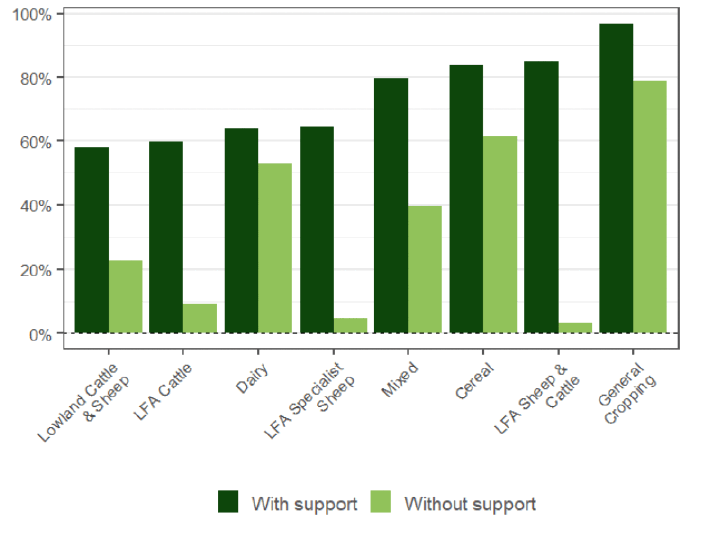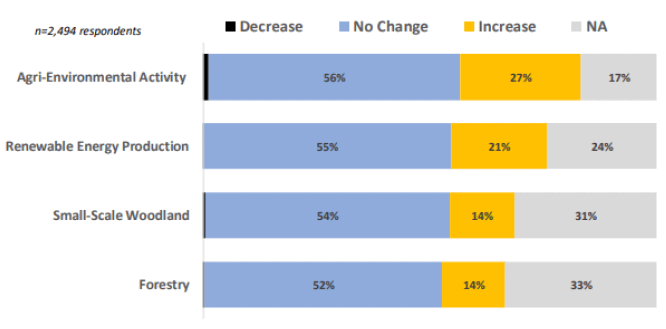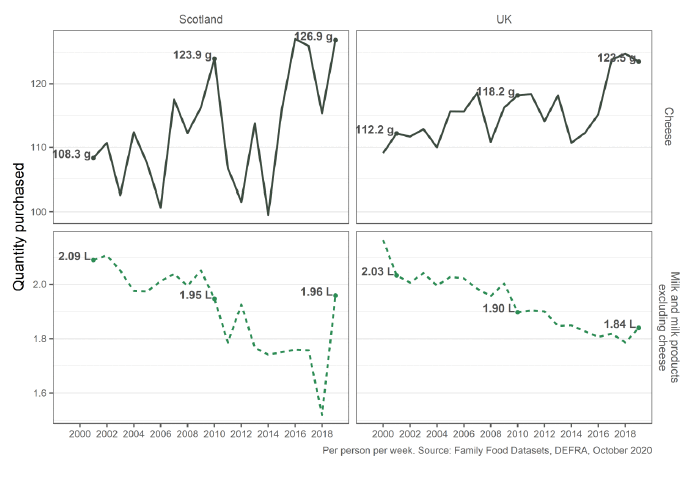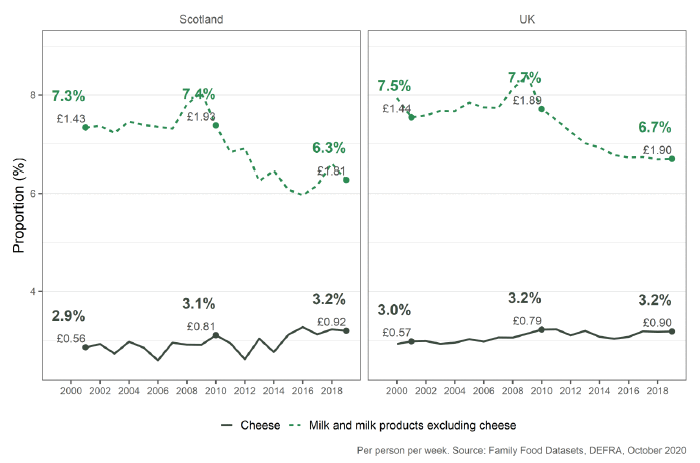Dairy Farmer-led Group: climate change evidence
A summary of existing evidence around the dairy sector, including greenhouse gas emissions produced by Rural and Environment Science and Analytical Services (RESAS) division.
1 Context and Structure
1.1 Composition of the Dairy Sector
1.1.1 Definition
Data on farms that specialise in dairy, and data on the total dairy holdings, are both important to understanding the overall Scottish dairy sector. Farms where more than two-thirds of output comes from dairy are categorised as dairy farms. A glossary and definitions of these categories and other terms can be found in Annex A.
Unless otherwise stated, data in this chapter are drawn from the June Agricultural Census, Total Income from Farming (TIFF), and the Farm Business Survey (FBS), with further detail available in Annex B.
1.1.2 Outputs and Value
In 2019, Scottish farmers produced about 1.3 billion litres of milk and milk products, accounting for around 9% of the UK's total milk production. Typically ranging between 1.2 billion to 1.4 billion litres per year, production levels in Scotland have remained fairly stable since 2003. Despite this the value of output does fluctuate, driven by changes in price per litre.[2]
In 2019, the value of Scotland's milk production was around £377 million. This was down £23 million on the previous year and £77 million less than the sector's recent peak in 2014. Milk and milk products account for around 11% of total Scottish agriculture output by value, roughly equivalent to the combined output associated with Scottish wheat and barley in 2019.
At the same time, Scotland's dairy farmers are responsible for a proportion of output associated with finished cattle – referred to as dairy beef. While providing a precise monetary value is complex, analysis carried out by the SRUC suggests that, in 2019, around 13% of Scotland's finishing herd was kept on specialist dairy holdings.
Data for the Scottish dairy sector is often reported in one of two ways:
- 'Specialist dairy' holdings, where two-thirds or more of output are from dairy.
- Output from all holdings with dairy cows (which accounts for smaller dairy producers and/or farms with a third or less of their total output from dairy)
Milk production in Scotland comes from both 'specialist dairy' farms and from farms holding any number of dairy cows (even if that is not their primary output). Both types of data are valuable to understanding the overall Scottish dairy sector. The Economic Report on Scottish Agriculture's figures for 2019 primarily show the latter – data on farms with any number of dairy cows. The Farm Business Survey shows farm income for specialist dairy farms in Scotland. The specialist dairy sector's output, input, and income for 2018/2019 is shown in Section 1.2.1.
1.1.3 Scottish Dairy Herds
| 176,000 | 89,000 | 56,000 |
|---|---|---|
| Female dairy cows[3] in Scotland in 2019 | Other adult female dairy cattle in Scotland in 2019 | Female dairy calves in Scotland in 2019 |
In Scotland in 2019, there were 265,000 female dairy cattle (aged one year or over) and 56,000 female dairy calves (aged less than one year), over two-thirds of which were located in Southern Scotland. This includes 176,000 dairy cows (aged two years or over with offspring), of which 78% were located in Southern Scotland.
Within the South West, Dumfries & Galloway had the highest concentration of both dairy cattle and calves. For example, holdings in Dumfries & Galloway held 82,000 dairy cows, nearly half of all dairy cows in Scotland.
| NUTS2 Region | Female Dairy Calves (000's) | Female Dairy Cattle (000's) | ||
|---|---|---|---|---|
| Aged < 1 year | Dairy cows* | Other female dairy cattle** | Total | |
| North Eastern Scotland | 2 | 6 | 3 | 9 |
| Eastern Scotland | 6 | 16 | 8 | 24 |
| Southern Scotland | 43 | 137 | 69 | 206 |
| Highlands and Islands | 3 | 10 | 5 | 15 |
| West Central Scotland | 2 | 7 | 4 | 11 |
| Total | 56 | 176 | 89 | 265 |
* Female dairy cattle aged 2+ years, with offspring. ** Female dairy cattle aged 1-2 years or aged 2+ years without offspring. Source: ERSA 2020, Table C10 (ii), provisional figures. Available at: https://www.gov.scot/publications/economic-report-on-scottish-agriculture-tables-2020-edition/
More than two thirds of Scotland's dairy cows, and nearly three quarters of holdings with dairy cows, are located on LFA land.
| LFA | Non-LFA | Total | ||||
|---|---|---|---|---|---|---|
| Holdings | Number | Holdings | Number | Holdings | Number | |
| Dairy Cows | 1,204 | 120,580 | 423 | 55,240 | 1,627 | 175,820 |
| Dairy Cows - Proportions | 74% | 69% | 26% | 31% | 100% | 100% |
Dairy cows made up 10% of all cattle in Scotland in 2019 (including beef), roughly half the proportion when looking at the UK total: 19% of all cattle in the UK were dairy cows. England, Wales, and Northern Ireland all had higher proportions of dairy cows to all cattle – which highlights Scotland's relatively higher proportion of beef cattle.
| Country | Female Dairy Cattle (000's) | Total Cattle (000's) | Dairy Cow Proportion (%) | |
|---|---|---|---|---|
| Dairy cows* | Other female dairy cattle** | |||
| Scotland | 176 | 89 | 1,728 | 10.2 |
| England | 1,131 | 476 | 5,280 | 21.4 |
| Wales | 252 | 118 | 1,120 | 22.5 |
| Northern Ireland | 314 | 145 | 1,612 | 19.5 |
| Total | 1,871 | 829 | 9,739 | 19.2 |
* Female dairy cattle aged 2+ years, with offspring. ** Female dairy cattle aged 1-2 years or aged 2+ years without offspring. Source: ERSA 2020, Table C8, provisional figures. Available at: https://www.gov.scot/publications/economic-report-on-scottish-agriculture-tables-2020-edition/
1.1.4 Farm Size
The Economic Report on Scottish Agriculture's figures for 2019 show that the 27% (434) of holdings with the largest dairy herd hold 73% of the total dairy herd in Scotland.
- A large proportion of holdings with dairy cows (621 holdings or 38% of all holdings with dairy cows) have a herd size of 1-4 dairy cows.
- Herd sizes between 5-149 dairy cows are less common (572 or 35%), while 434 holdings (27%) held 150 dairy cows or more.
Of these, only 651 holdings were specialist dairy farms, while the remaining 976 were classed as a different farm type.
| Dairy cow herd size | Holdings | Proportion of holdings (%) | Dairy cows* | Proportion of dairy cows (%) |
|---|---|---|---|---|
| 1-4 | 621 | 38.2 | 950 | 0.5 |
| 5-19 | 105 | 6.5 | 970 | 0.6 |
| 20-49 | 58 | 3.6 | 1,850 | 1.1 |
| 50-74 | 80 | 4.9 | 5,010 | 2.8 |
| 75-99 | 92 | 5.7 | 8,140 | 4.6 |
| 100-149 | 237 | 14.6 | 29,780 | 16.9 |
| 150 -299 | 313 | 19.2 | 64,420 | 36.6 |
| 300-499 | 79 | 4.9 | 30,110 | 17.1 |
| 500-799 | 24 | 1.5 | 14,830 | 8.4 |
| 800-999 | 8 | 0.5 | 6,900 | 3.9 |
| Over 1000 | 10 | 0.6 | 12,870 | 7.3 |
| Total | 1,627 | 100.0 | 175,820 | 100.0 |
* Female dairy cattle aged 2+ years, with offspring. Source: ERSA 2020, Table C11, provisional figures. Available at: https://www.gov.scot/publications/economic-report-on-scottish-agriculture-tables-2020-edition/
1.1.5 Workforce
Figures from the 2019 June Agricultural Census show the distinction between specialist dairy holdings and holdings with any number of dairy cows (as mentioned in Section 1.1.2) in terms of workforce.
| Category | Specialist Dairy | All Holdings with Dairy* | ||
|---|---|---|---|---|
| Holdings | Workforce | Holdings | Workforce | |
| Occupiers and spouses working more than half time | 577 | 766 | 1,305 | 1,706 |
| Occupiers and spouses working less than half time | 209 | 217 | 522 | 571 |
| Full-time employees | 499 | 1,369 | 952 | 2,367 |
| Part-time employees | 267 | 429 | 529 | 834 |
| Casual and seasonal workers | 113 | 175 | 237 | 369 |
| Total workforce | 634** | 2,956 | 1,494** | 5,847 |
* Female dairy cattle aged 2+ years, with offspring. ** Labour data was not available for all 651 specialist dairy farms. Source: June Agricultural Census 2019, via RESAS Agricultural Analysis Unit
Specialist dairy farms had an average workforce of 4.7 employees (including owner-occupiers), while holdings with any number of dairy cows had an average of 3.9 employees.
Specialist dairy holdings were also more likely to have full-time employees: 499 specialist dairy holdings out of 634 had full-time employees (79%), making for a total of 1,369 full-time employees or around 2.7 employees per holding on average. When looking at all holdings with dairy cattle, only 64% had full-time employees, averaging 2.5 employees per holding.
1.2 Profitability and Turnover
1.2.1 Estimated Farm Business Incomes and Profit
Farm Business Income (FBI) statistics are estimated from a sample of nearly 500 farms with a standard output (the average monetary value of the agricultural output at farm-gate price) over €25,000. The FBS does not collect information on non-supported sectors, which include farms predominantly engaged in horticulture, pigs, poultry and some fruit production. A large number of part-time and small Scottish farms with low output are also not included[4].
Farms with more than two thirds of their output from dairy are categorised by the FBS as specialist dairy farms. A glossary and definitions of these and other terms is in Annex A.
Table 6 below shows estimated FBI by upper and lower performance band, based on income with and without support payments. FBI figures measure profitability from agricultural activity and includes income from non-agricultural activities using farm resources. For example, tourism, renewables or processing and sale of farm products. There are wide variations in performance across farm types.
In 2018-19, the average Farm Business Income (FBI) in Scotland was around £38,700. Excluding support payments, this figure falls to around -£4,700, suggesting that for many Scottish farms CAP support plays an important role. On average, specialist dairy farms show higher profitability with an FBI of around £66,000, falling to £26,400 when support payments are excluded.
| Farm business income by performance band – dairy farms | ||||||
|---|---|---|---|---|---|---|
| Lower 25% | Average | Upper 25% | ||||
| Including Support | Excluding Support | Including Support | Excluding Support | Including Support | Excluding Support | |
| Specialist Dairy | -£50,600 | -£104,800 | £66,000 | £26,400 | £241,000 | £191,400 |
| All Farms | -£15,500 | -£53,800 | £38,700 | -£4,700 | £159,800 | £100,800 |
The figure below shows profitability by farm type, represented by the proportion of farms with income from farming greater than zero (i.e. agricultural output is greater than input). Over 60% of dairy farms were profitable with support payments and, in comparison to other farm types, this drops relatively little when support payments are removed.

Scottish Government analysis shows that across all farm types, 28% of farm businesses turn a profit without support, and 72% turn a profit when support is included.
On average, specialist dairy farms have an output of around £590,000, and receive around a further £40,000 from subsidies and payments. Inputs are around £560,000 a year, with the largest part associated with livestock expenses. The economic efficiency is calculated as a ratio of outputs to inputs. Therefore, the average dairy farm has an economic efficiency of around 108%.
1.2.2 Diversification
Data on diversification and investment in renewable energies on dairy farms in Scotland is scarce. The Farm Structure Survey 2016 found that across all farming around 9% of farms made more than 50% of their turnover from diversified activities and 16% made more than 10%. 92% of dairy farms made between zero and ten per cent of their turnover from diversified activities. Between 2013 and 2016 the number of dairy farms making more than 10% of their turnover from diversification increased from 4% to 8%.
The Farmers' Intention Survey 2018, summarised by SRUC in their October 2019 briefing, revealed that over 50% of (Scottish) farmers (from all sectors) plan no changes to the levels of agri-environmental provision on their holding in the succeeding five years. Between approximately 14% and 27% of farmers plan to increase provision of "public goods" through increased agri-environmental, forestry, small-scale woodland and renewable energy production.
Of those who did signal intentions to increase these activities, identification of a successor, status as a new entrant, tenure, gender and land type were the most significant characteristics of those intending to increase public good based activities. Lower productivity of land appears to be a factor which positively influences the decision of farmers to increase the level of forestry and small-scale woodland on their farm or holding.
The figure below shows the overall intentions of the farmers, crofters and smallholders surveyed to change the level of activities on their farm or holding that may enhance 'public good' provision in the next five years (2018-2023). Over 50% of respondents planned no changes to the level of each of the activities and for many the question was not applicable as they currently don't engage in that activity. The type of public good provision that most respondents planned to increase is agri-environmental activity, at 27%.

1.3 Future Trends
1.3.1 Impacts of Brexit
In late 2020, the Anderson Centre produced a report for Scottish Government, assessing the impacts on Scottish agriculture of a UK-EU Free-Trade Agreement (FTA), and a No-Deal Brexit.
Overall, the modelled impacts of an FTA were projected to result in relatively small changes in Scottish agricultural output over the longer term. This is because agricultural trade, with the exception of seed potatoes, can continue effectively tariff-free, aside from additional non-tariff measures (NTM). Indeed, the modelling suggests that increased demand from the rest of the UK could actually increase Scottish agricultural output in some cases.
Specifically for dairy, output was projected to increase by around 0.6%. It should also be noted that this kind of modelling is not suitable for capturing the initial disruption being experienced in the very near term by individual businesses in the early stages of the deal.
Trade between the UK and EU, however, is no longer frictionless with new non-tariff measures (NTM) – additional certifications, enhanced border checks, etc. – now in place. As a result, the costs of such trade are set to increaseFor most dairy products the NTM costs are estimated between 0.8% and 1.7% of their price (also referred to as ad-valorem equivalent ,AVE[5]). EU importers are also subject to higher costs due to NTMs so some Scottish producers may see increased domestic demand from relative price improvements in their produce compared to EU imports.
The study states that added friction will support domestic prices, if key export markets for cheddar are safeguarded and enough processing capacity exists for increased milk volumes. This is crucial as Scotland does not have capacity to process all the milk it produces.
1.3.2 Changing Dietary Demands
DEFRA's Family Food datasets, based partly on ONS' Living Costs and Food Survey, provide an overview of UK and Scottish household purchases and expenditure of food and drink. The latest release, showing data up to 2018/2019, shows that the volume of milk and milk products (excl. cheese) purchased in the UK has declined (the volume of cheese purchased, however, has increased by c.a. 13% since 2000). Generally, Scottish households have seen a similar decrease in the volume of milk and milk products (excl. cheese) purchased between 2000-2017 (-16%). However, the large decrease and subsequent increase in 2018 and 2019 do not reflect wider UK household consumption.

In 2018/2019, Scottish households purchased on average 1.96 litres of milk per week, and 127g of cheese per week for in-home consumption. In terms of expenditure, this totalled £2.73 total per week, or 9.5% of total weekly expenditure on food and drink for in-home consumption (for UK households, this totalled 9.9%)
| Category | UK | Scotland | ||
|---|---|---|---|---|
| Purchase | Expenditure | Purchase | Expenditure | |
| Milk and milk products, excl. cheese | 1,840 ml | £1.90 | 1,960 ml | £1.81 |
| Cheese | 123 g | £0.90 | 127 g | £0.92 |
| Food and Non-Alcoholic Drinks | .. | £28.32 | .. | £28.85 |
Source: Family Food 2018/2019, October 2020
While expenditure has remained broadly stable for cheese (2.9% in 2000, 3.2% in 2018/2019), expenditure on other milk products has decreased since the financial crisis of 2008/2009 (which saw a peak of 7.4% of food and drink expenditure or £1.93 pppw).

A number of key reports have discussed changes to red meat consumption. The UK Climate Assembly[6] – a citizens' assembly on climate change – discussed their preferred future for food, farming and land use on the path to net zero in the UK. This included 20-40% voluntary and education driven reductions in red meat and dairy consumption.
The Climate Change Committee[7] have also formally modelled these reductions in their 6th Carbon Budget report in order to determine their pathways for the UK, including Scotland, to reach net-zero by 2050.
Their advice also highlights three key changes required to reduce agricultural emissions:
i. diet change with their main pathway to net-zero assuming a 20% reduction in UK consumption of dairy by 2030;
ii. low-carbon farming practices;
iii. productivity measures to improve crop yields and reduce stocking rates.
The sectoral pathway for Scottish agriculture in the CCC report requires an emissions reduction of 23% by 2030 and the CCC state changes in farming practices, woodland planting and reductions in livestock numbers are all required to achieve net zero.
The Ambition 2030 delivery programme sets out a structure for the Scottish farming, fishing, food, and drink sectors' development and growth up to 2030. This was jointly funded by Scottish Government and industry, and has introduced programmes such as a co-op sector development programme and a regional and island food development.
Contact
There is a problem
Thanks for your feedback